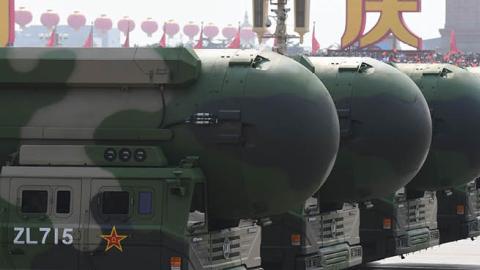The military threat from Beijing is accelerating at a pace few anticipated. Recently released satellite imagery shows that China is rapidly constructing nearly 300 hardened underground silos in its western desert to house intercontinental ballistic missiles. Also unexpected was the revelation that China recently began work on a third site of similar size near Ordos City that was not previously associated with ICBMs.
This indicates that the Chinese have dramatically increased their operationally deployed strategic nuclear warheads beyond even what was forecast by the Defense Department a year ago. The type of Chinese missile expected to be loaded into these particular silos is currently in serial production, so it won’t be long before these sites reach their full capability. According to Adm. Charles Richard, commander of U.S. Strategic Command, the scope and scale of these activities should be considered a “strategic breakout by China.”
Why was the West caught so off-guard? The U.S. and its allies have a persistent difficulty grasping the underlying aspirations of China’s economic, foreign and defense policy, resulting in dangerous misestimations of China’s security advances. The U.S. assumed China would always retain Mao’s “minimum deterrence” approach to nuclear weapons.
China aims to become the leading global economic and military power by midcentury. Although President Xi Jinping outlined this aspiration in 2011, it wasn’t formalized until the 19th Congress of the Communist Party of China in 2017. The evidence affirms that China is seeking global military dominance, not “parity” with the West.
An early clue to China’s approach to defense modernization emerged as it built a Navy to meet global, not regional security needs. China’s naval shipbuilding infrastructure facilitated a rapid increase in naval vessels: By 2030 China’s naval forces will have an estimated 415 surface vessels and 99 manned and unmanned submarines, while the U.S. will have a maximum of 350 manned and unmanned surface ships and 66 submarines.
China has added an additional capability not found in Western navies: a capacity to control the sea from land. In August 2020, China launched an intermediate range missile from Western China and a medium range ballistic missile from Eastern China. This flexible, land-based capability could augment China’s naval forces almost anywhere in the world. The U.S.’s planned naval modernization efforts are far behind what will be needed to avoid being outflanked by China.
Western expectations for growth in China’s nuclear force were upended by obsolescent assumptions about the Chinese goal of minimum deterrence—a small number of missiles sufficient for deterrence in some circumstances, but little else. Since President Xi took office, China has increased the size and sophistication of its nuclear delivery systems. While China’s missiles were silo-based a decade ago, Beijing has developed a triad of land, sea and air-based nuclear capabilities. The Defense Department estimates the Chinese have 350 nuclear warheads, of which roughly 250 are operationally deployed. But Defense warned in 2020 that these forces would double by 2030.
China’s newest ICBMs have been deployed in a rail and road-mobile configuration. When not on rail or road deployment, these systems are stored in 3,100 miles of tunnels throughout the country.
The Center for Strategic and International Studies reports that one new Chinese missile, the long-range DF-41 ICBM, is designed to deliver as many as 10 independently targetable warheads with nuclear yields ranging from 20 to 250 kilotons. This capability, along with a new submarine-launched missile with six warheads and a new strategic bomber, could allow China to deploy more than 3,000 warheads on top of the 350 existing warheads.
The silo-based component of China’s nuclear force alone could be larger than the 1,550 operational nuclear warheads permitted to the U.S. or Russia under the 2009 New START agreement and could exceed the total number of U.S. and Russian strategic nuclear weapons by 2030. The likelihood of further growth in the number of China’s strategic nuclear delivery systems is high given the momentum in its modernization program.
Even more worrying, in 2016 China also established its Strategic Support Force to enable the integration of cyber, space, electronic and information warfare with its nuclear operations. This approach provides China with a means to integrate all the most significant instruments of national power with its nuclear forces.
How can the U.S. respond to these alarming developments? The current recapitalization and modernization of the U.S. deterrent was based on assumptions about peer-competitor nuclear aspirations when President Obama signed New START. But the optimism Mr. Obama expressed in his 2009 Prague speech on disarmament no longer reflects global realities. The world has underestimated China’s determination to field dominant military capabilities in naval forces and strategic nuclear forces.
What’s next? China’s militarization of space.
Read in the Wall Street Journal














